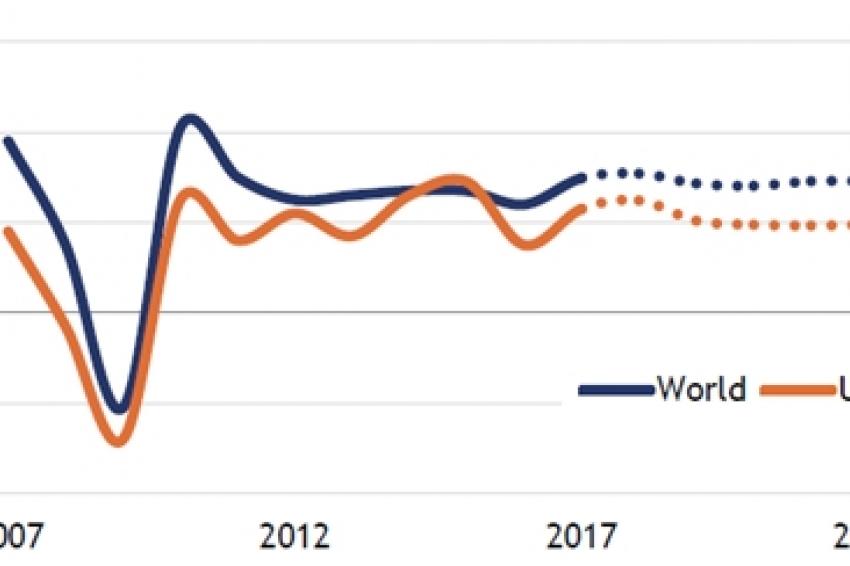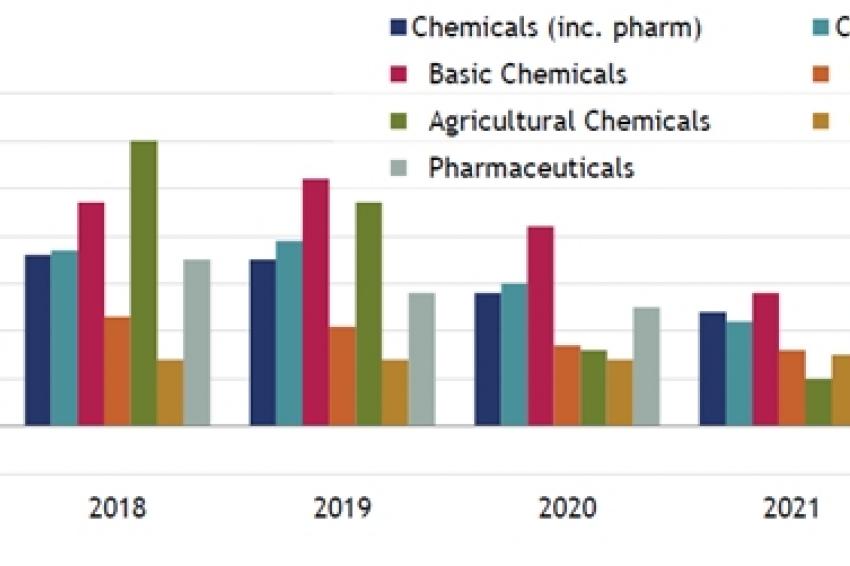US Chemical Industry Is Riding the Global Upswing
ACC’s 2017 Year-End Situation and Outlook
Against the backdrop of synchronous global growth, American chemistry output held its own in 2017 despite hurricane disruptions. For the first time in a decade, the world’s major economies are on an upswing, in concert.
In the United States, manufacturing has turned a corner, business investment is on the rise and domestic oil and gas production is on the rebound. Major end-use markets, supported by growth in trading partner economies have improved, setting the stage for gains in US chemical production during 2017. Despite these gains, Hurricane Harvey paused production temporarily and took a bite out of volumes during the third quarter. In addition, inventories are rising, albeit from low levels. However, US chemical manufacturers remain advantaged with access to cheaper and more abundant feedstock and energy and, as a result, there has been significant capital investment in American chemistry. As these investments have been coming online, chemical production volumes, particularly in basic chemicals, have continued to improve in 2017, with significant gains expected in 2018 and 2019.
During 2017, output gains have been led by agricultural chemicals, coatings, and other specialties, as well as bulk petrochemicals, reflecting the renewed competitiveness arising from shale gas. Continued gains in manufacturing and exports during 2018 and beyond will drive demand for basic chemicals, especially those segments in which the United States enjoys a renewed competitive advantage. Improved business activity in domestic end-use markets and exports will support growth for most specialty segments.
In the United States, continued gains across a broad band of industrial sectors were supporting economic growth last year. Housing, business investment, and their supply chains have momentum. Light vehicles, which remain solid, softened slightly in 2017. Looking ahead to 2018, investment and industrial activity is expected to strengthen. With rising performance across the world, export markets are expected to expand.
American Chemistry is undergoing a renaissance as new investments come online and additional investments are announced. These investments will capitalize on the profound and sustainable competitive advantage enabled by shale gas development. In addition, the industry continued to add high-paying American jobs for a fifth consecutive year. Chemical companies in the United States continue to innovate, focusing on improving efficiencies as well as on new, leading-edge product development.
American Chemistry Gaining Momentum
The recovery in the oil and gas sector – and the concurrent improvement in related investments – is a leading factor behind the stronger economic growth figures. This past year’s gain in equity markets occurred amid an environment of greater consumer, small business, and other business confidence. Business investment and inventories generally contribute to variations in the business cycle, and thus these measures are continually monitored. Although business investment in the United States was weak in late-2015 and into 2016, higher confidence and trends in new orders reflect recovery in 2017. The need to enhance productivity and competitiveness will foster continued gains in business investment in 2018 and 2019. US economic growth will also include continued strength in consumer spending.
Overall, modest growth in the US economy can be seen by examining the trends in ACC’s Chemical Activity Barometer (CAB). The CAB is a composite index of economic indicators that track the activity of the chemical industry. Due to its early position in the supply chain, chemical industry activity leads that of the broader economy, and thus the CAB can be used to anticipate potential turning points in the overall economy. Currently, the CAB is signaling continued growth in the US economy through mid-2018.
Outside the United States, a synchronized upswing among major and regional economies is occurring for the first time since the mid-2000s. World trade is reviving after lagging world GDP in 2015 and 2016. Global manufacturing, which softened during 2015 and 2016, was strengthening in 2017. Europe is on a roll and the outlook for Asia is optimistic; however, Latin America remains problematic. India will continue to grow at a stronger pace than China, which is suffering from problems such as overcapacity in manufacturing. Brazil and Russia have emerged from their recessions. Long-term global growth potential will be reached next year.
US Industrial output rose in 2017, growing by 1.7% after back-to-back years of declines due to weak export markets, a high dollar, and fallout from the collapse in oil prices. With synchronous economic growth around the world, the global appetite for US exports has increased. In addition, renewed investment in oil and gas and housing has stimulated production through related supply chains. The recovery in business investment has also led to broad-based gains across multiple manufacturing industries. Industrial output is expected to strengthen in 2018 and 2019 with growth of 2.4% and 2.3%, respectively.
Drivers of Strong Gains in US Chemistry
Industrial output rebounded in 2017 across a diverse set of chemistry-consuming industries and export markets also improved. At the same time, new shale-advantaged capacity started to come online. In late August 2017, however, hurricane Harvey caused widespread, though temporary, disruptions to the heart of the US chemical industry. As a result, output of chemicals (excluding pharmaceuticals) rose by only 0.8% during 2017. With pharmaceutical production off 1.3%, overall chemistry output was flat in 2017. Due to positive tailwinds from stronger industrial growth across the world and large capacity expansions still to come, the outlook for US chemistry remains robust with growth rates exceeding overall industrial production over the next five years. Chemical output is expected to grow by 3.7% in 2018 and 3.9% in 2019. Capacity utilization is expected to slip during the next few years, from 73.8% in 2017 to 72.5% by 2022, as additional supply comes online.
Development of shale gas has created a definitive advantage for US chemical manufacturing. Looking ahead over the next five years, production from the unprecedented investment in US chemical manufacturing will continue to come online, with the largest gains expected in 2018 and into 2019. In addition, a second wave of investment is on the way. Much of the new production will be exported to customers around the world.
US basic chemicals continue to enjoy a competitive advantage from shale gas and improved end-use markets (both domestic and abroad); however, hurricane disruptions caused headwinds during the past year. Basic chemicals (inorganic chemicals, petrochemicals, plastic resins, synthetic rubber, and manufactured fibers) production is anticipated to be flat in 2017, before growing by 4.7% in 2018. With new capacity coming on stream, production volumes will grow by 5.2% in 2019 and 4.2% in 2020, followed by smaller gains in 2021 and 2022. Basic chemicals exports, led by bulk petrochemicals and organics, as well as plastic resins, will play a large role in expanding production. Major export markets include Latin America, Asia, and, to a smaller degree, Europe. In addition, there will be strength in the production of inorganic chemicals and synthetic rubber as well.
US competitiveness in chemicals improved in 2017. Continued gains in domestic production of natural gas and natural gas liquids ensure ample supplies of fuel and feedstock. At the same time, oil prices and competing naphtha-based production costs increased through the third quarter 2017, expanding the US comparative advantage.
In the specialties chemicals segment, production will pick up by 3.0% in 2017, and grow further by 2.3% in 2018. Gains in specialty chemicals were led by improvement in oilfield and mining chemicals, adhesives, and electronic chemicals. Demand for specialty chemicals is expected to grow in the coming years as the manufacturing and construction sectors accelerate.
US Remains Destination for Chemical Investment
The United States has been favorably re-evaluated as an investment location and petrochemical producers have announced significant expansions of capacity in the US, reversing a decade-long decline in the 2000s. In fact, the gains to basic olefins capacity during the 2010s are estimated at nearly 40%. Indeed, nearly 320 new chemical production projects, valued at over $185 billion altogether, have been announced through late-November 2017; 62% of these are foreign direct investment (FDI) or include a foreign partner.
During recent years, chemistry has accounted for one-half of total construction spending by the manufacturing sector. Despite the hindrance of slow global growth, economic uncertainty, and US tax policies that discourage business investment, these strong gains in chemical industry capital spending should continue. US chemical industry capital spending increased by 6.0% this year but will average 6.3% in 2018 and 6.8% in 2019 as many projects have been stretched out. Growth resumes in the 2020-2022 period, averaging 7% per year. By 2022, US capital spending by the chemical industry will reach $48 billion.
Access to plentiful and affordable natural gas supplies is allowing the United States to capture an increasing share of global chemical industry investment. This trend will continue as the United States remains the destination for chemical industry investment.
Capital spending for bulk petrochemical and organic intermediates, along with spending for plastic resins, will dominate. Spending for buildings and structures present strong opportunities during this period, beginning with spending for site preparation and utilities and then building and installation taking over. Major process equipment has largely been specified and procured for most projects although delivery will still occur.
US Feedstock Advantage Will Grow Chemical Exports
The US chemical industry will post a $32 billion trade surplus in chemicals (excluding pharmaceuticals) this year as exports (on a dollar basis) rose 4.9% to $127 billion and imports rose 2.8% to $96 billion. Some sectors of competitively advantaged chemicals trade are expanding on a volume basis but, with low oil prices pulling down sales figures, growing exports are not as easily apparent in the headline (including pharmaceuticals) trade numbers. Two-way trade between the US and its foreign partners will reach $223 billion in 2017, a 4.0% expansion from 2016. Total trade will rise steadily for the remainder of the forecast period. The high US dollar will continue to pose a challenge over the next year, at least, as it makes US exports relatively more expensive, eroding the competitiveness of American firms operating in the global market. However, broad and sustainable improvements in the economies of many of its trading partners have brightened the outlook for US chemicals export demand considerably.
Overall, the outlook for US chemicals exports is positive. Following three years of contraction, US chemical exports will rise 4.9% in 2017 and will continue to expand over the forecast period with peak growth in 2019. At that point, the impact of the high dollar will have moderated and new industry investment will have come online. Assuming there are no major disruptions to the trade scenario, by 2022 there will be a $73 billion trade surplus in chemicals (excluding pharmaceuticals) driven by a $64 billion trade surplus in basic chemicals.
Conclusion
At the end of 2017, the business of chemistry has largely recovered from the effects of the hurricanes and the stage is set for significant growth in output as new production capacity comes online and demand firms in key end-use markets in the US and abroad. Inventories imbalances are easing, thus increasing demand for chemistry will be met by new production rather than stock drawdowns. Significant additions to capacity will result in above-trend growth in basic chemicals over the forecast horizon, in addition to solid output growth in other segments.
The United States continues to enjoy a competitive advantage from shale gas and abundant new supplies of natural gas liquids: nearly 65% of the chemical industry investment announced since 2010 has been completed or is currently under construction. As new production expands to meet growing global demand, employment in the business of chemistry will further accelerate. The industry is expected to continue adding high-paying jobs through the end of the decade. US chemical exports (excluding pharmaceuticals) are growing and, as external demand becomes more robust, this trend will take off.







